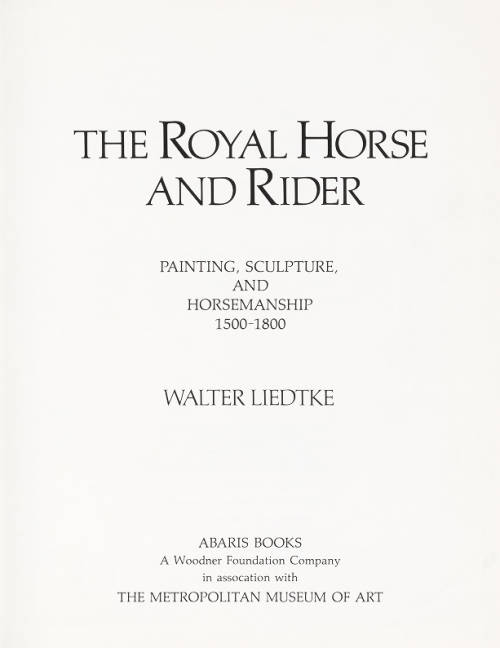
|
L’ouvrage est entièrement numérisé et disponible sur le site : |
||||||||||
|---|---|---|---|---|---|---|---|---|---|---|---|
| The royal horse and rider : painting, sculpture, and horsemanship, 1500-1800 / LIEDTKE Walter, 1989 | |||||||||||
The royal horse and rider : painting, sculpture, and horsemanship, 1500-1800 — Walter
Liedtke.
/
LIEDTKE Walter
|
|||||||||||
|
|||||||||||
| Anglais | |||||||||||
| EAN | 9780898352672 |
« […] Riding experts, in my experience, have in common with art historians the tendency
to think that they are absolutely right on any point concerning their particular subject,
even though both disciplines are far from being "hard sciences", require aesthetic
discrimination, and involve what might be called trial and error land sometimes punishment
and reward) methodologies. Thus dressage instructors, trainers, breeders, and even
authors of books on the horse in art (or the horse in history, as seen in art) will,
like patrons and peasants of past times, pronounce this or that painting of a horse
to be "wrong", or at least indicative of poor breeding in the horse, the rider, or
the artist, Here enthusiasts of equitation might benefit from consultation with an
art historian, even one unable to discuss riding forms, since he or she can explain
that art, too, depends upon stylistic conventions as well as nature : what might seem
to the horseman an absurdity in a picture or statue could well be the continuation
of a venerable tradition or a deliberate departure on the part of the artist (who
himself may have been a good horseman) from every day experience.
It follows from these remarks that no riding master, and no art historian, will have
the last word on the subject and that this book will draw a lot of criticism. My "Apology"
as prefatory remarks once were called, is that the text is not intended as a definitive
survey but rather as a "study", the record of a student’s reading and looking at the
relevant material I have concentrated upon a few questions that seemed inadequately
treated in the literature such as the relationship between
Rubens
and Velázquez in respect to this genre and the levels of meaning that were on scerned
in royal equestrian portraiture. More broadly the text attempts to sketch out the
main lines of development, from the Renaissance onward, of the formal types to which
equestrian portraits and monuments conformed.[…]. » Présentation de l’éditeur (1989)
: Baroque , École espagnole de Vienne , exposition , gravure , haute-école , histoire , histoire de l’art , iconographie , peinture , portrait , Renaissance , sculpture , symbôle